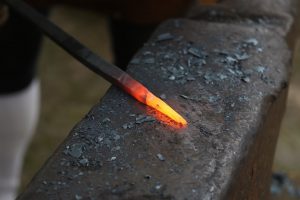
Whether it’s steel, iron, aluminum or copper, metal is often exposed to heat to alter its physical properties. Known as heat treatment, it’s been around for thousands of years, with some of the earliest examples dating back to the eighth century B.C. when European blacksmiths would heat iron to make it more pliable and workable. Today, heat treatment is still performed for the purpose of altering a metal workpiece’s physical properties, but there are now several types of heat treatment processes.
Differential Hardening
Differential hardening is a heat treatment process that involves heating and cooling two or more areas on a metal workpiece at different rates. Knives, for example, are often manufactured using this process to achieve a hard, sharp edge with a softer and more flexible spine. When a company is producing a knife, it may coat the spine — the dull side of the blade — with an insulator like clay before quenching it in water. With an insulator on the spine, this area of the knife will cool more slowly than the actual blade, thereby making it softer and more flexible.
Annealing
Annealing is a heat treatment process in which a metal workpiece is heated and then slowly cooled to trigger the formation of micro-sized crystals and, therefore, increase its strength and hardness. When performed on either ferrous or nonferrous metals, annealing creates pearlite, which of course is particularly strong. Pearlite can only be created by cooling iron or iron alloy metals, typically at a slow rate.
Stress Reduction
Also known as stress relieving, stress reduction is a heat treatment process that’s designed to reduce stresses within a metal workpiece. It’s often used in the production of metal products or components that are intended to hold pressure, such as boilers.
Normalizing
Normalizing is a heat treatment process that lives up to its namesake by evenly distributing or “normalizing” the composition of a metal workpiece. It typically involves heating a metal workpiece up to a specific temperature, after which the workpiece is air-cooled. Like annealing, normalizing produces pearlite, though it’s also capable of producing other metal microstructures like martensite and bainite.
Decarburization
Finally, decarburization is a heat treatment process that’s designed to lower the carbon content of steel. If a steel workpiece has too much carbon, it may be too soft for its intended application. Therefore, manufacturing companies often perform decarburization to lower the carbon content of their steel workpieces.
